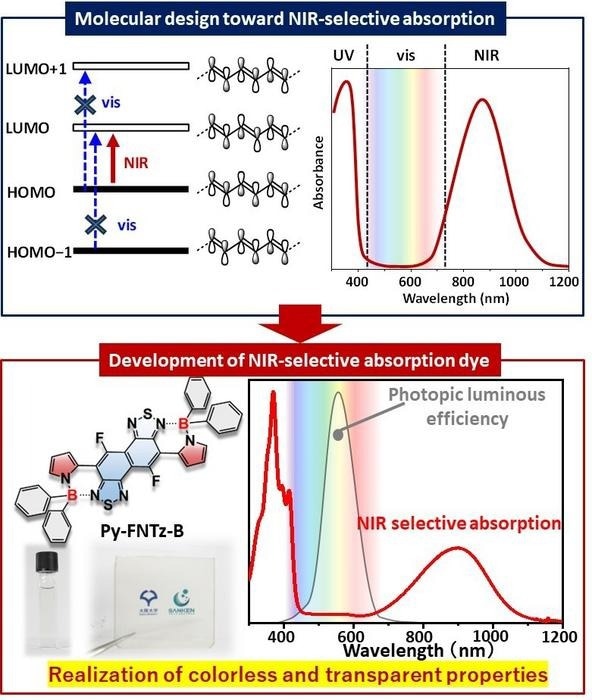Reviewed by Lexie CornerJun 18 2024
Researchers from SANKEN at Osaka University designed complex molecules that appear transparent and colorless but absorb near-infrared light . They achieved this by carefully building molecules with appropriate electron configurations. The research was published in the journal Advanced Science.
 Molecular design of colorless NIR-selective absorbing dye. Image Credit: Osaka University
Molecular design of colorless NIR-selective absorbing dye. Image Credit: Osaka University
Controlling a molecule is not always simple. For instance, the precise arrangement of electrons in an organic molecule determines the wavelengths of light it can absorb; this can be challenging to adjust. Nevertheless, the capacity to create materials that react exclusively to particular portions of the spectrum may result in significant new uses.
The development of novel organic semiconducting materials for high-tech devices like transistors and solar cells is attracting much attention. Specifically, colorless molecules with the ability to absorb near-infrared light but not visible light find use in photodetectors and chemotherapy, among other applications.
Although some of these compounds have already been created, there is currently no organized method for producing these molecules.
An organic compound's ability to absorb light depends on the movement of electrons between orbitals, which are areas around atoms. This paper demonstrates the scientists' rigorous approach to creating molecules with orbitals that permit the absorption of certain light wavelengths but not others.
The main challenge was finding a rational approach to constructing molecules with the desired electronic transitions. To do so, we focused on large structures having many delocalized electrons, using theoretical calculations to guide our selections.
Soichi Yokoyama, Study Lead Author, Osaka University
Based on the so-called donor-acceptor-donor system, these compounds used boron bridges, pyrrole or indenopyrrole donor groups, and a naphthobisthiadiazole group as the acceptor. The precise kind of light absorption was produced by the electrons' ability to disperse over larger regions of the molecules, thanks to this unique shape.
After a thorough analysis, it was discovered that the novel molecule would, as anticipated, absorb near-infrared light rather than visible light.
A somewhat similar molecule absorbing near-infrared radiation was reported some time ago, but this compound also absorbed visible light and so appeared blue. Our goal was to find a molecule that showed no color at all, to allow specific applications. A combination of an extended polyene structure and orbital symmetry were key.
Yutaka Ie, Study Senior Author, Osaka University
It was discovered that the molecule functioned as a semiconductor, and the pyrrole-based substance could be utilized to create a phototransistor that could detect near-infrared light. Untapped applications exist for organic molecules exhibiting distinct optoelectronic qualities and particular light absorption traits.
It is anticipated that this discovery will open the door to the design of transparent, colorless molecules that react to near-infrared light in the future, opening up a wide range of new uses.
Journal Reference:
Yokoyama, S., et al. (2024) Colorless Near‐Infrared Absorbing Dyes Based on B‐N Fused Donor‐Acceptor‐Donor π‐Conjugated Molecules for Organic Phototransistors. Advanced Science. doi.org/10.1002/advs.202405656